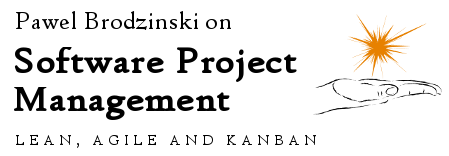Most change initiatives fail. How many of them? Well, let’s see.
In 1995, John Kotter published research that revealed only 30 percent of change programs are successful. Fast forward to 2008. A recent McKinsey & Company survey of business executives indicates that the percent of change programs that are a success today is… still 30%
This is from a McKinsey report. How about different sources?
According to international management consultants Bain & Co, 70 to 90 per cent of organizational change initiatives fail.
Now, obviously these statistics receive some criticism. After all, what is a change initiative? What is a success? My point is that what we see is that in different context we suck big time at improving how we work.
What’s more we are not improving really. Over the course of past 15 years we’ve seen a huge rise of the methods and approaches that are specifically aimed toward driving the change management.
Agile proposed a neat value container quickly filled with specific methods that should change and improve the way we work. Lean offered a thinking pattern focused on continuous improvements. Both are more and more frequently considered table stakes than game changers. Why nothing is changing then?
First, let me make a bold observation: neither Agile nor Lean seem to be making a difference. In fact, that’s not only my observation. Daniel Mezick points that:
If current approaches actually worked well, then by now, thousands of organizations would have reached a state of self-sustaining, “freestanding” agility.
We have to be doing something wrong. Dave Nicolette offers some ideas what that might be. Anyway with such a wild popularity of Agile and Lean we should expect to do better than that. The problem is that most of the time we don’t even try to understand what made them work in the first place.
That’s a sad observation, but most of the time when I hear an Agile or Lean experience report it simply covers methods, practices and tools. The problem is that neither of these is pivotal in any change initiative. Basically, adopting practices and tools is simply a cargo cult. That’s not going to work unless there’s something more, the same way as it didn’t work for the Pacific tribes after the World War II.
In agile context we often mention values as the missing bit. I sort of agree with that. Sort of because the way Agile Manifesto is formulated it creates false dichotomies, yet it points us the right direction.
There’s a problem with values though. You don’t introduce values simply stating that you have them. You don’t incept them through mission statements and stuff. By the way, do any of you know value statement of your org by heart? Values are derivative of everyone’s behaviors and attitudes, thus they are a result of organizational culture.
There’s one more layer to that. Values can’t be inconsistent with the culture. Otherwise authenticity is gone and your claims about values have little to do with reality.
In other words a company can’t adopt Agile Manifesto simply by stating so. Not a surprise that change initiatives around Agile so frequently boil down to methods and tools. Not a surprise they fail at a high rate.
We see the same story with Lean as well. The bits that get traction are tools and techniques. It is so often when I see teams acting like limiting work in process, doing Gemba walks and having Kaizen boards was everything there was to improve continuously.
It’s not going to fly, sorry. We are back to organizational culture and everyone’s everyday behaviors. What do people do when they see an issue? Do they feel empowered to do whatever the hell they believe is the right thing to do to fix that issue? Do they even know what is the ultimate value they produce so they get good guidance on what is an issue in the first place?
These behaviors tell a lot about the culture. Unfortunately most of the time answers for the questions above suggest that there’s no freaking chance to make the tools work the way we intend them to. Typically we see over-constrained, siloed organizations where one neither knows what is the right thing to do nor has courage to go beyond the constraints.
I keep getting flak for bringing this up over and over again but I will do it once more.
It’s easier to ask forgiveness than it is to get permission.
Grace Hopper
Grace Hopper’s famous words are, in my opinion, the essence of the bit we are missing when introducing Lean or Agile to our organizations. That very bit is responsible for the appalling rate of success of change initiatives.
You can have all the hot tools and practices in place but when your people are driven by fear of consequences of their actions nothing will change. “Fear” may sound harsh but that’s what it is. It doesn’t mean that changing status quo by a tiny bit scares the crap out of me. It’s enough that I start thinking about potential consequences, what my bosses would think about that and whether they would even be happy. This is fear too.
When I think about the situation from a perspective of my experience as a manager I’m not surprised. I mean, really, promoting this whole “don’t ask permission” attitude is going to backfire on you on occasions. What’s more it means giving up control. Even worse, it assumes trust. It assumes trust to everyone, not only to few trusted people. Now, this is a huge leap of faith management has to take.
If you are thinking about continuous improvement or making your change initiatives work start with this leap of faith. If you can’t make it work don’t bother with all the tools, methods, practices and stuff. It’ll be just a waste of time. And the best part is that to make this work leaders have to start with themselves.
Only then you can dream of influencing culture so that it supports the everyday acts of leadership on all levels. If you got it right you may actually start thinking about all the helpful stuff you can introduce to keep the changes running. In fact, it’s pretty likely that you won’t need so much guidance as lots of them will emerge.
Oh, and if you wonder whether that change among leaders and managers is easy, well, it involves lots of pain and suffering. It is against of what we’ve been (wrongfully) taught for years. Sorry.


 Subscribe RSS feed
Subscribe RSS feed Follow on Twitter
Follow on Twitter Subscribe by email
Subscribe by email



1 comment… add one
Great blogpost Paweł and well written too.
I have similar thought wondering in my head from some time, nice to see I’m not only one that thinks techniques and tools is not a good starting point and that they are not sufficient for lasting change.